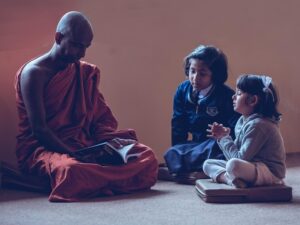
A Comprehensive Guide
Yoga is often associated with physical postures, but it is so much more than that. It is a holistic practice that encompasses the mind, body, and spirit. The eight limbs of yoga, as outlined in the Yoga Sutras of Patanjali, provide a comprehensive roadmap for living a meaningful and balanced life. These limbs are not just steps to follow; they are interconnected practices that guide us toward self-awareness, inner peace, and spiritual growth. Let’s explore each of the eight limbs in detail, understanding their significance and how they work together to create a harmonious life.
The Foundation: Yama – Ethical Standards
The first limb of yoga is Yama, which focuses on ethical principles and moral conduct. Yama teaches us how to interact with the world around us in a way that is respectful, compassionate, and mindful. There are five Yamas, each offering a guideline for living harmoniously with others and with ourselves.
Ahimsa – Non-Violence
Ahimsa is the practice of non-violence, not just in actions but also in thoughts and words. It encourages us to avoid causing harm to any living being, including ourselves. This principle extends beyond physical harm to emotional and mental harm. For example, speaking harshly to someone or being overly critical of yourself violates Ahimsa. By practising Ahimsa, we cultivate kindness, compassion, and empathy, creating a more peaceful environment for everyone.
Satya – Truthfulness
Satya is the practice of truthfulness. It encourages us to be honest in our words and actions, but with a caveat: truth should always be expressed with compassion. This means avoiding harsh or hurtful truths that may cause harm. Satya also invites us to be truthful with ourselves, acknowledging our strengths and weaknesses without judgment. Living in alignment with Satya fosters trust and authenticity in our relationships.
Asteya – Non-Stealing
Asteya goes beyond the literal act of stealing. It encourages us to avoid taking what is not freely given, whether it’s material possessions, time, or energy. For example, showing up late to a meeting or expecting others to do your work for you can be a form of stealing. Asteya teaches us to respect the boundaries and resources of others, fostering a sense of fairness and gratitude.
Brahmacharya – Moderation
Brahmacharya is often translated as celibacy, but its broader meaning is about moderation and balance. It encourages us to use our energy wisely, avoiding excess in all areas of life, whether it’s food, work, or relationships. By practising Brahmacharya, we learn to channel our energy toward what truly matters, leading to greater focus and fulfilment.
Aparigraha – Non-Possessiveness
Aparigraha is the practice of non-attachment and non-possessiveness. It encourages us to let go of our attachment to material possessions and outcomes. This doesn’t mean we can’t enjoy the things we have, but rather that we shouldn’t let them define us. Aparigraha teaches us to live simply and appreciate what we have, freeing us from the constant desire for more.
The Second Limb: Niyama – Personal Observances
While Yama focuses on our interactions with others, Niyama turns the focus inward. It consists of five personal practices that help us cultivate self-discipline, self-awareness, and spiritual growth.
Saucha – Purity
Saucha is the practice of cleanliness, both externally and internally. Externally, it involves keeping our bodies and surroundings clean. Internally, it refers to purifying the mind by letting go of negative thoughts and emotions. Saucha creates a sense of clarity and lightness, allowing us to approach life with a fresh perspective.
Santosha – Contentment
Santosha is the practice of finding contentment in the present moment. It encourages us to appreciate what we have rather than constantly striving for more. Santosha doesn’t mean we should stop setting goals, but rather that we should find joy in the journey rather than fixating on the destination. By practicing Santosha, we cultivate gratitude and inner peace.
Tapas – Discipline
Tapas is the practice of self-discipline and perseverance. It involves committing to our goals and staying consistent, even when faced with challenges. Tapas can be applied to any area of life, whether it’s maintaining a yoga practice, eating healthily, or working toward a personal goal. Through Tapas, we build resilience and strength.
Svadhyaya – Self-Study
Svadhyaya is the practice of self-reflection and self-study. It encourages us to explore our inner world, understanding our thoughts, emotions, and behaviors. Svadhyaya also involves studying sacred texts and teachings to gain wisdom and insight. By engaging in Svadhyaya, we deepen our self-awareness and grow on a spiritual level.
Ishvara Pranidhana – Surrender
Ishvara Pranidhana is the practice of surrendering to a higher power or divine presence. It involves letting go of the need to control every aspect of our lives and trusting in the greater plan. This doesn’t mean we stop taking action, but rather that we release attachment to the outcomes. Ishvara Pranidhana fosters humility and a sense of connection to something greater than ourselves.
The Third Limb: Asana – Physical Postures

Asana is perhaps the most well-known limb of yoga, referring to the physical postures practised in yoga. However, asanas are not just exercises; they are tools for preparing the body and mind for deeper spiritual practices.
Purpose of Asana
The primary purpose of asana is to create a strong and healthy body that can sit comfortably for meditation. Asanas also help us develop discipline, focus, and awareness. By moving the body mindfully, we learn to connect with our breath and cultivate presence.
Common Asanas
There are countless asanas, each with its own benefits. For example, downward dog strengthens the arms and legs while stretching the spine. Tree pose improves balance and focus, while child’s pose promotes relaxation and introspection. Each asana offers an opportunity to explore the connection between the body and mind.
Connecting Body and Mind
Asanas teach us to be present in the moment, observing how the body feels and how the breath flows. This mindfulness carries over into other areas of life, helping us approach challenges with calm and clarity.
The Fourth Limb: Pranayama – Breath Control
Pranayama is the practice of controlling the breath, which is considered the life force or prana. By regulating the breath, we can influence the mind and energy levels.
Importance of Breath
Breath is a powerful tool for calming the mind and energizing the body. When we feel stressed, our breath becomes shallow and rapid. By practicing Pranayama, we can slow down the breath, activating the parasympathetic nervous system and promoting relaxation.
Types of Pranayama
There are many Pranayama techniques, each with its own benefits. Ujjayi breath, often used in yoga classes, involves breathing deeply through the nose with a slight constriction in the throat. Kapalabhati is a cleansing breath that involves forceful exhalations, while Nadi Shodhana (alternate nostril breathing) balances the left and right hemispheres of the brain.
Practicing Pranayama
Start with simple techniques, such as deep belly breathing. Gradually explore more advanced practices, always listening to your body and avoiding strain. Pranayama can be practiced on its own or as part of a yoga session.
The Fifth Limb: Pratyahara – Withdrawal of the Senses
Pratyahara is the practice of turning inward by withdrawing from external distractions. It is a bridge between the external practices of yoga (Yama, Niyama, Asana, Pranayama) and the internal practices (Dharana, Dhyana, Samadhi).
Why Pratyahara Matters
In today’s world, we are constantly bombarded with sensory input, from screens to noise to endless to-do lists. Pratyahara helps us disconnect from these distractions, creating space for self-reflection and inner peace.
How to Practice
Begin by reducing sensory input. Turn off your phone, sit in a quiet space, and close your eyes. Focus on your breath or a mantra, gently bringing your attention back when it wanders. Over time, you’ll find it easier to tune out distractions and turn inward.
Benefits
Pratyahara calms the mind and prepares us for meditation. It also enhances self-awareness, helping us understand our thoughts and emotions more clearly.
The Sixth Limb: Dharana – Concentration
Dharana is the practice of focused attention. It involves training the mind to concentrate on a single point, such as the breath, a mantra, or an object.
The Role of Dharana
Concentration is a skill that requires practice. By focusing the mind, we reduce mental clutter and create a sense of calm. Dharana is an essential step toward meditation.
Techniques for Dharana
Choose a focal point, such as a candle flame or a mantra. Gently bring your attention back to this point whenever the mind wanders. Start with short sessions and gradually increase the duration.
Building Focus
With consistent practice, you’ll notice improvements in your ability to concentrate. This skill carries over into daily life, helping you stay present and focused on tasks.
The Seventh Limb: Dhyana – Meditation
Dhyana is the practice of meditation, a state of deep awareness and stillness. Unlike Dharana, which involves focused attention, Dhyana is a state of effortless awareness.
What Is Meditation?
Meditation is not about stopping thoughts but observing them without attachment. It is a state of being fully present, free from judgment or distraction.
How to Meditate
Find a comfortable position and focus on your breath or a mantra. Allow thoughts to come and go without engaging with them. Over time, you’ll experience moments of stillness and clarity.
Benefits of Meditation
Meditation reduces stress, improves mental clarity, and fosters a sense of peace. It also deepens our connection to ourselves and the world around us.
The Eighth Limb: Samadhi – Enlightenment
Samadhi is the ultimate goal of yoga, a state of oneness with the divine. It is a state of bliss and transcendence, where the ego dissolves, and we experience unity with all that is.
Understanding Samadhi
Samadhi is not something that can be achieved through effort; it is a state of being that arises naturally when the mind is still and the heart is open.
The Path to Samadhi
Samadhi is the culmination of the other seven limbs. By practising Yama, Niyama, Asana, Pranayama, Pratyahara, Dharana, and Dhyana, we prepare ourselves for this profound experience.
Experiencing Oneness
In Samadhi, we transcend duality and experience the interconnectedness of all things. This state brings profound peace and a deep sense of fulfilment.
Integrating the Eight Limbs into Daily Life

The eight limbs of yoga are not meant to be practised in isolation; they are interconnected steps that guide us toward a balanced and meaningful life. By incorporating these practices into our daily routine, we can cultivate physical health, mental clarity, and spiritual growth. Start small, be patient, and remember that the journey is just as important as the destination.





